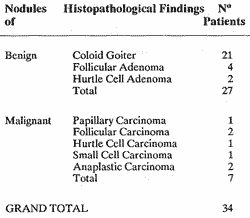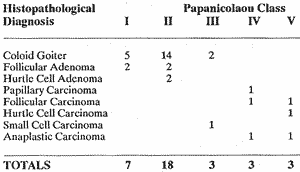

Year: 1992 Vol. 58 Ed. 1 - (1º)
Artigos Originais
Pages: 7 to 9
Fine needle aspiration biopsy of thyroid solitary nodules
Author(s):
José Vietor Maniglia, M.D.* ,
Paulo Augusto L. Pontes, M.D.** ,
Hornilton Leite Soares, M.D.***
Keywords: thyroid, needle biopsy
Abstract:
Thirty four patients with eutltyroid, "cold" nodules of lhe tinyroid gland were worked up using fine needlle aspiration biopsy (FNAB). Samples were classifted by lhe Papanicolaou method Pathological correlation revealed a sensitivity of 1000lo, speciftcity of 93,5% and accurancy of 9-1,4% for tine test. Fine needle aspiration biopsy is noa a substitute forsutgeay. It is a valuable diagnostic procedure, and should be perfonned in ilne evaluation of essentially ali thyroid nodules.
![]()
INTRODUCTION
Needle aspiration biopsy (FNAB) has been used as a diagnostic tool in the evaluation of thyroid disease lince 1920, when Martin and Ellis introduced this technique 1.
Fine needle aspiration biopsy of thyroid nodules has been a popular procedure in Europe for many years2,3.
This tecnique has gained wide acceptance in the United States, South America, and many other countries4-17.
Many studies have clearly demonstrated the superiority of FNA cytology in sensitivity and cost-effectiveness in lhe evaluation of thyroid nodules as compared to lhe other diagnostic modalities now available17,18.
Fine needle aspiration biopsy is an excellent tool to improve the diagnostic accuracy of thyroid nodules. It enhances lhe ability to select lesions most likely to be malignante while diminishing lhe incidente of unnecessary surgey 10 - 12,18
The aim of lhe present report was to evaluate FNAB results at our institution. The reliability of findings and correlation with surgical pathology would then help us to develop confidente in the future management of our patients. In this paper we present our fmdings in 34 patients subjected to FNAB and then referred to surgery and the cytohistological correlation with final histopathological diagnosis.
MATERIAL AND METHODS
We have studied 34 patients, 3 males and 31 females whose ages ranged from 27 to 83 years.
The patient were referred for lhe evaluation of solitary thyroid nodules. All nodules were found to be "cold" by radioãctlve iodine.
All patients had normal levels of thyroid stimulating hormone (TSH), T3, and T4.
AR patients were submitted to preoperative evaluation consisting of otolaryngological-head and neck examination, urinalysis, CBC and differential and serum biochemical tests.
All patients were found to have "cold" solitay thyroid nodules.
TECHNIQUE OF FINE NEEDLE ASPIRATION BIOPSY
Local anesthesia was not required. A 20 ml plastic disposable syringe is the most satisfactory size coupled with a 21,22 or 23 gauge needle.
After the skin is cleaned with antiseptic, the tumor mass is held firmly. With one hand the needle is inserted directly into it. The plunger of the syringe is pulled back, thus exerting suction. This is maintaned with the thumb and the needle is moved through the tumor three times in different directions. Still with the needle in the tumor, suction is slowly released. The needle is removed from the tumor and disconnected from the syringe, which is filled with a few mililiters of air and then reconnected to the needle and the contents sprayed on three clean dry slides, which are immediately fixed with 95% ethylacohol and stained by hematoxilin and eosin.
Interpretation of the slides was done by an experienced cytologist who was unaware of the clinicai fmdigs. Reading was according to the Papanicolaou method7:
CLASS 1
ABSENCE OF ATYPICAL CELLS
CLASS II
ATYPICAL CELLS WITHOUT SIGNS OF MALIGNANCY
CLASS 111
ATYPICAL CELLS WITH SIGNS OF MALIGNANCY
CLASS IV
CYTOLOGY SUGGESTIVE OF MALIGNANCY
CLASS V
CYTOLOGY CONCLUSIVE OF MALIGNANCY
All patients were subjected to surgery and the specimens submitted to frozen and permanent sections. Sensitivity, specificity and accuracy were calculated using the formule defmed by ASP el al. 8 as follows:
TRUE POSITIVE (T.P.): cases in which the FNAB findings interpreted as auspicious for malignancy were proved to be malignant in the final diagnosis.
FALSE POSITIVE (F.P.): Cases in which the FNAB was interpreted as malignant or "suspicious" for malignancy but no mafignancy was found.
TRUE NEGATIVE (T.N.); Cases in which the FNAB was interpreted as benign and in which no malignancy was found.
FALSE NEGATIVE (F.N.): Cases in which the FNAB was interpreted as "benign" but in which malignant tissue was found.TABLE 1
RESULTS
The results o€ the aspiration biopsy are shown on Table 1. The correlation of the final histopathological diagnosis and the five classes of Papanicolaou are summarized on Table II.
DISCUSSION
Thyroid nodular disease is considered a major clinicai entity in United States and in Latin America, thus it is very important to have a test that woud be simple, cost effective and sensitive for diagnosing possible malignancy in three lesions.
At present, FNAB is the most accurate method for selecting patients for surgey. It is also the most cost effective and has the highest sensitivity/specificity ratio of all the diagnostie modalities currently availablel 10/12.
In our study we obtained a sensitivity of 100, specificity of 93,5% and accuracy of 94,4%. These figures compare favorably with other reports. Wide variations is accuracy are observed12,14
Ramaccioti 10, has reported a 10% incidente of malignancy in Class II lesions. In our study we found no malignancy in 25 patients with Class I and Class II lesions. On the other hand, ali patients reported as Class IV and Class V were demonstrated to have malignant lesions in the frozen and permanent histopathological evaluation.
From the three patients presented as Class 111, two resulted as having benign lesions and one as malignant, which demonstrated the incidente of false positive.TABLE 2
Based on our study and the experiente reported in the literature we recómmend conservative management for all patients included in Papanicolaou classes 1 and II, while patients diagnosed by FNAB as Papalinolaou classes IV and V should be submitted to surgicai exploration. Patients diagnosed as Papanicolaou class III should lave the FNAB repeated and, if again it conftrms the previous diagnosis, surgery is recommended.
Fme needle aspiration biopsy is easy, safe, cost-effective and a highly sensitive technique that represents a very important and reliable diagnostic tool in the evaluation of thyroid nodules.
BIBLIOGRAFIA
1. MARTIN,II. and ELLIS, E.B.: Biopsy by needle puncture and aspiration. Ann Surg, 92:169-181,1930.
2. LOW1IAGEN, T.; GRANBERG,P. et al.: Aspiration biopsy cylology (ABC) in nodules of the thyroid gland suspected to be malignant. Surg Clin North AM. 59:3-18,1979.
3. SORDERSTROM, N.: Punct ure of goiters for aspiration biopsy. Acta Med Scand,144:237-244,1952.
4. WANG, C.; VICKERY, A.L., et al.: Needle biopsyof the thyroid. Surg Gynecol Obstet, 143:365-368,1976.
5. RIESTA, J.L.; MARTINEZ, J.H., et al.: Fine needle aspiration of the thyroid-cytopathologic correlation. Bol Assoe Med P Rico. - 332-334,1986.
6. CROCKFORD, P.M.; BAI, G.O.: Fine needle aspiration biopsy. Can Med Assoe 1,110:1029-32,1974.
7. PAPANICOLAOU, F.N.: Criteria of malignancy. Atlas of exfoliative cytology, Cambridge Harvard'Press, G.N. Papanicolaou, ed. p.13-21,1963.
8. ASP, A.A.; GEORGITIS, W., et al.: Fine needle aspiration of the thyroid. Am J Med. 83:489-493,1987.
9. HAMBERGER, B.; GHARIB, H., et at.: Fine needle aspiration of thyroid nodules. Am J. Med, 73:381-382,1982.
10. RAMACCIOTI, C.E.; PRETORIUS, H.T., et al.: Diagnostic accuracy and use of aspiration biopsy in management of thyroid nodules. Arch Med., 144:1169-1173,1984.
1l . RUDOWSKI, W.: Critical evaluation of aspiration biopsy in the diagnosis of tumors of the thyroid. Am J. Surg., 95:40-44, 1958.
12. CRILE, G. Jr; HAWK, W.A. Jr.: Aspiration biopsy of thyroid nodules, Surg Gunecol Obstet. 136:241-245,1973.
BIBLIOGRAFIA
13. FRABLE, W.J.: Thin-needle aspiration biopsy. Am J.Clin. Patho1.65:168-182,1976.
14. ASHCRAFT, M.W; VAN HERLE, A.J.: Management of thyroid nodules II; scanning techniques, thyroid suppressive therapy, and fine needle aspiration. Head Neck Sure, 2:297-322,1981.
15. SUEN, K.C.; QUENVILLE, NT.Tine needle aspiration biopsy of the thyroid gland: a study of 304 cases. J.Clin Pathol.,365:1036-1045, 1983.
16. SMEDS, S.; MADSEN, M., et al.: Evaluation of preoperative diagnosis and surgical management of thyroid tumors. Acta Chir Scand,150:513-519,1984.
17. BUGIS, S.P.; YOUNG, J.E., et aLDiagnostic accuracy of fine needle aspiration biopsy versus frozen section in solitaty thyroid nodules. Am. J. Sury.; 152:411-415,1986.
18. KELLER, M.P.; CRABBE, M.M., et al: Aecuracy and significance of fine needle aspiration and frozen section on determining the extent of thyroid resection. Sureery, 01:632-635,1986.
* Professor Titular pelas Disciplinas de Otorrinolaringologia e Cirurgia de Cabeça e Pescoço. Fundação Faculdade Regional de Medicina - São José do Rio Preto, São Paulo, S. P. - Brazil.
** Professor adjunto e Livre Docente. Departamento de Otorrinolaringologia e Distúrbio da Comunicação Humana. Escola Paulista de Medicina - São Paulo, Brazil.
*** Chefe do Departamento de Patologia Santa Casa de Misericórdia de Franca. Franca, São Paulo, Brazil.
Trabalho realizado na Disciplina de Otorrinolaringologia Fundação Faculdade Regional de Medicina, São José do Rio Preto, São Paulo. Santa Casa - Franca, São Paulo
Endereço para correspondência: Jose Victor Maniglia - Rua Ondina, 45 - CEP. 15.015 - São José do Rio Preto, São Paulo - S.P. - Fone. (0172) 21-3863

